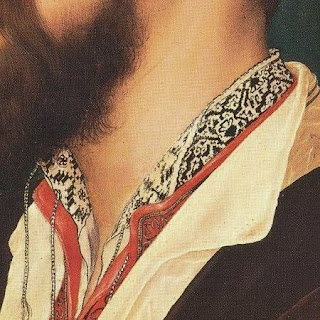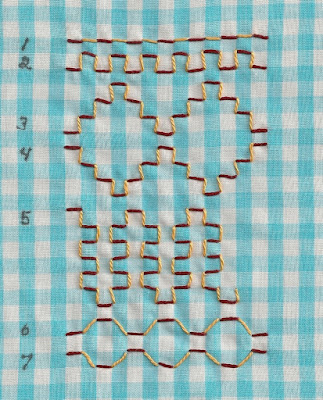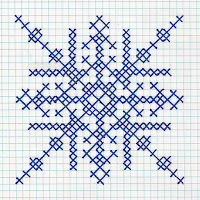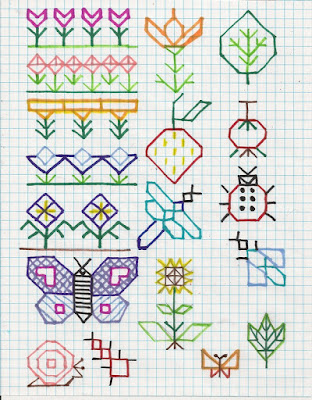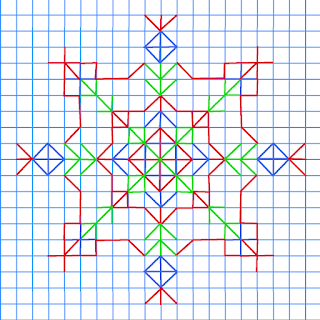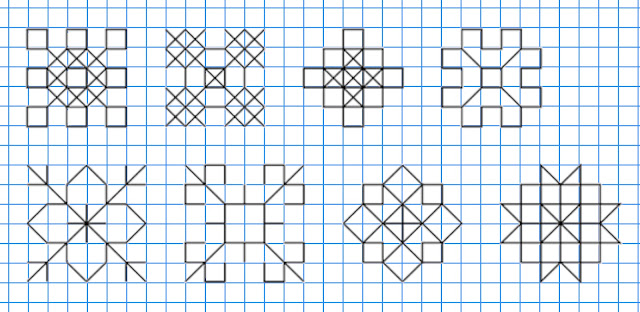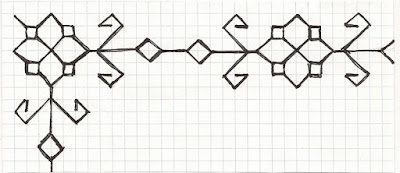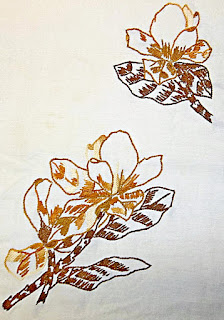(Last month I promised to revisit the subject of crewel embroidery. This is a topic that we posted on in 2015 and 2016. To prevent too much duplication of information and techniques, I will give you links to those posts from time to time.)
An article in one of our regional newspapers cited the return of interest in embroidery. As someone who never
lost interest, I found this very encouraging. It said some new embroideries were less about decoration than in past decades, and they tended more toward slogans and expressions of personal choice and opinion. There's certainly nothing wrong with that. Tee shirts and sweatshirts have been doing that for ages. Some designs were described as whimsical or comical. (If you want to sell your needlework, you
must be careful not to use a design based on copyrighted characters like Disney cartoons or syndicated comic strips.) A lot of work was called “very individualistic”. I always encourage readers to use the techniques you've learned to create something uniquely your own. Even when I provide a pattern, I try to describe how you can vary it greatly in color, stitches, background material, etc. You can even use the same pattern to create an entirely different form of needle art, or use it in a different medium entirely. These are points I intend to strongly emphasize in upcoming posts.
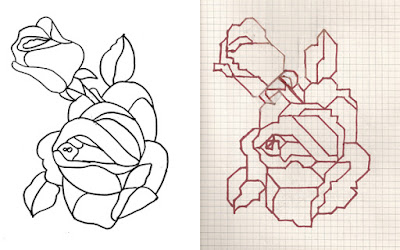 |
| Drawing, turned into a needlepoint chart, works for crewel as well |
The word
crewel refers to the type of yarn, a loosely twisted 2-ply (2-strand) wool yarn. Traditionally,
crewel embroidery is done with a 2-ply wool yarn on a medium-grade to fine-grade linen.
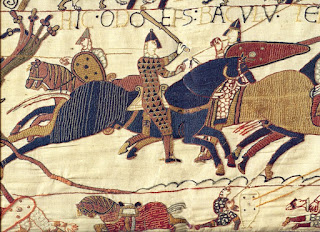 |
| Detail from the Bayeux Tapestry |
One of the oldest (and largest) pieces of crewel embroidery still in existence is the Bayeux Tapestry, depicting William the Conqueror's victory over England in 1066 AD. (Although
called a tapestry, it is really a huge embroidery rather than a woven tapestry.) You might have seen recent news stories about this famous work. (Look
here and
here.) The piece, believed to have been made by needleworkers in Normandy and completed about 1100 AD, is 231 feet long (!) and 20 inches high. Besides land and sea battles, it shows many details about the costumes, artifacts, techniques and customs of the era.
 |
| Crewel pillow cover |
Like Spanish blackwork, crewel embroidery became popular in England during the reign of Queen Elizabeth I. She loved roses and native wildflowers, so those motifs were widely used, along with leaves and vines like those in this much more recent (20th century) pillow cover. One of the major functions of this type of embroidery was to provide warmth: the embroidery added weight and thickness to bed curtains, canopies, draperies and wall coverings made of linen or wool. The work was usually done by a number of needleworkers supervised by an experienced embroiderer who may also have designed the motifs. Lovely examples of this work are exhibited at the Victoria and Albert Museum in London.
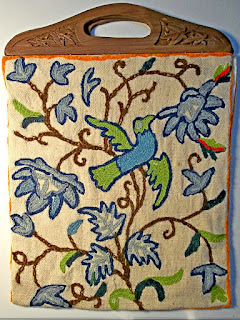 |
| Modern bag embroidered in the Jacobean style |
Crewel embroidery reached the peak of its popularity during the reign of Queen Elizabeth I 's successor, King James I, who liked to do the embroidery himself. (Crewel was never considered ‘un-manly’ in much of the world.) The work of this period was also called Jacobean Embroidery. This 20th-Century European handbag is done in the Jacobean style. The designs were heavily influenced by Chinese and other Oriental fabrics, porcelains, and lacquer-work beginning to be imported into England at that time. The Jacobean influence can still be discerned in modern crewel embroidery. Dragons and other mythical creatures were also popular in the 17th Century.
Early colonists brought crewel patterns and techniques to the New World, where they became quite popular. Some of the stitches commonly used were running stitch, double running stitch, back-stitch and cross-stitch. These basic stitches were further embellished by such techniques as whipping, lacing, and interlacing. If more experienced embroiderers will bear with me for a few paragraphs, I will demonstrate these stitches for beginners.
A
running stitch (also called a basting stitch) is one that covers the same number of threads each time, leaving a blank space of the same number of threads between the stitches.
A
double running stitch starts at the end of the running stitch line, often with a second color, and fills in the spaces between the running stitches.
The next row shows a running stitch (dark blue)
whipped (overcast) with a second color. That second color stays on top of the fabric except at the two ends.
The next row shows a double running stitch in two colors that is then whipped with a third color.
This next stitch is the
laced running stitch. It begins with a running stitch (dark blue). The second color (rose) stays on the surface of the fabric except at the ends. It is pulled into a little arc under each running stitch and forms a longer, shallower, downward arch between stitches. This gives it a scalloped appearance. If I were doing this on linens or a garment that needed to be washed, I would use thread from the background fabric to
couch the arches to the fabric. That is, I would hold the loops down with tiny upright stitches at the centers of the loops.
The
laced double running stitch starts with a double running stitch in two colors. Lace it with a third color. Because the arches are caught at the joining of two stitches rather than crossing an empty space between stitches, the top and bottom arches are the same size and the scalloped effect is gone. This is another stitch pattern that benefits from couching.
For the next pattern row, do the double running row in a single color. Keeping the second color on the surface except at the two ends, loop it around the places where the running stitches join. This is the
Pekinese stitch, which usually doesn't require couching.
If you know how to back-stitch, you can whip, lace, and do Pekinese stitches on rows of back-stitching as well, adding to your ‘vocabulary’ of stitches. Practice these stitches until you feel comfortable with them. You can use them for curved lines as well as straight ones, but you need to keep the stitches the same size as you do that.
As I noted earlier in this post, traditional crewel embroidery is done with a 2-ply wool yarn on a medium-grade to fine-grade linen. Some show judges will not let you call a piece "crewel embroidery" unless it is done this way. That was fine, I suppose, in the 17th Century when the technique was at its peak, but it
is the 21st Century, and time to broaden our horizons! Personally, I like to do this technique on wool or a good wool-like synthetic with anything from 1 to 5 plies of yarn (both wool and acrylic), using all kinds of flosses, metallic threads, etc., for special effects. I like crewel yarn and 3-ply Persian yarn that I separate as needed. Separating the plies also allows me to blend them by combining different colored plies together in my needle.
 |
| A blended yarn sampler |
Unfortunately, these yarns have become more expensive and harder to find. Also, some people are allergic to wool or simply can't afford it. Feel free to experiment with the cheaper, more readily available alternatives. You may find some acrylic and other synthetic yarns easier to embroider with than others. Practice with them so that you can make good choices
before you begin a project.
Crewel needles that are sold as such are usually designed to handle 1-ply or 2-ply yarn. If you want to work or experiment with more plies, you will need needles that have large enough eyes to accommodate the extra yarn. Try to get an assortment of needles with different lengths and sizes of eyes. The needles should have sharp points that slip between the threads of the background fabric. If the needle point punches a hole in the fabric, it is too large and heavy.
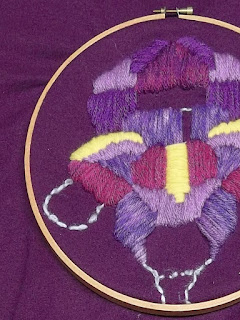 |
| Surface stitching anchored by the outline |
I also like to keep a variety of blunt-pointed tapestry needles on hand. Once I have outlined the edges of a design part, I often fill the center with stitches that lie flat on the fabric but do not penetrate it. They are held in place by running them underneath the outline stitches. While the yarn should not be loose enough to move out of its place on the surface of the fabric, it must not be pulled tight enough to pull the outline out of shape. This requires a little practice on a small piece of the fabric to get it just right. The blunt tapestry needle will slip under the outline stitches without splitting them.
You will need some sort of support for your work, otherwise it will eventually pull out of shape. If you are a beginner and doing small projects, start with a set of a 6-inch, 8-inch, and 10-inch hoops.
Please use wooden hoops. Metal and plastic ones slip. For more ambitious projects, you may want a frame. Here is a popular kind:
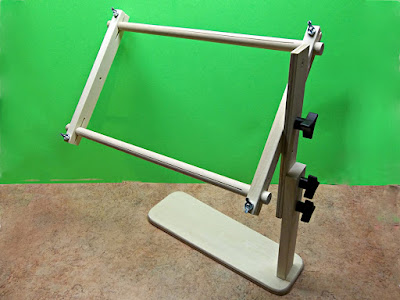 |
| Large adjustable needlework frame |
Some other things you will need, if you don't already have them at hand, include: a pair of small, sharp scissors; a bag or basket that never contains anything but your needlework; a well-fitting thimble (if you use one) and a ruler or measuring tape.
For the next "family" of crewel stitches, both beginners and experienced stitchers can follow this link:
Watch for another crewel article soon. Enjoy!
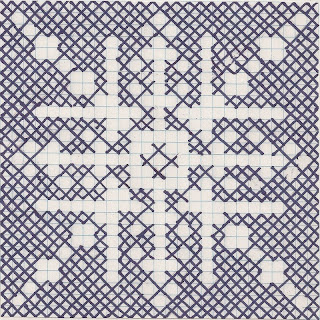
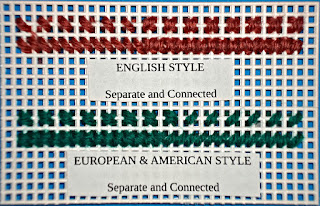
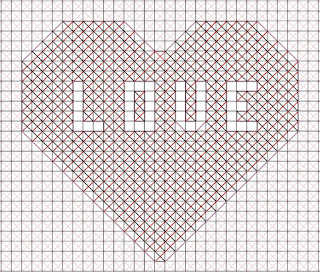
 This post by Annake's Garden is licensed under a Creative Commons Attribution-NonCommercial-ShareAlike 3.0 Unported License.
This post by Annake's Garden is licensed under a Creative Commons Attribution-NonCommercial-ShareAlike 3.0 Unported License.


